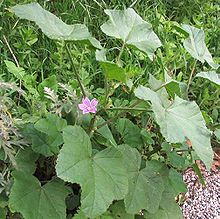Malva nicaeensis: Difference between revisions
| Line 26: | Line 26: | ||
== Plant properties == |
== Plant properties == |
||
In the Levant, mallows grow profusely after the first winter rains. The leaves and stems are edible, and are widely collected by indigenous peoples for food, as they make an excellent garnish when chopped and fried in olive-oil with onions and spices. In Israel, the Arabic name for this plant, "''chubezza'' |
In the Levant, mallows grow profusely after the first winter rains. The leaves and stems are edible, and are widely collected by indigenous peoples for food, as they make an excellent garnish when chopped and fried in olive-oil with onions and spices. In Israel, the Arabic name for this plant, "''chubezza''" {{lang-ar|'''الخبيزة'''}}, is well-known and is used also by Israelis whenever referring to the plant.<ref>Six Orders of the Mishnah, Eshkol Publishers: Jerusalem 1978, ''Mishnah Kila'im'' 1:8, Rabbi Obadiah di Bertinoro's Commentary, s.v. חלמית.</ref> |
||
==External links== |
==External links== |
||
Revision as of 20:37, 31 December 2014
This article needs additional citations for verification. (September 2010) |
| Malva nicaeensis | |
|---|---|

| |
| Scientific classification | |
| Kingdom: | |
| (unranked): | |
| (unranked): | |
| (unranked): | |
| Order: | |
| Family: | |
| Subfamily: | |
| Genus: | |
| Species: | M. nicaeensis
|
| Binomial name | |
| Malva nicaeensis | |
| Synonyms | |
|
Malva arvensis | |
Malva nicaeensis is a species of flowering plant in the mallow family known by the common name bull mallow.
It is native to Eurasia and North Africa, and it is known on other continents as an introduced species and sometimes a weed.
Description
Malva nicaeensis is an annual or biennial herb producing a hairy, upright stem up to 60 centimeters long. The leaves are up to 12 centimeters wide and have several slight lobes along the edges.
Flowers appear in the leaf axils, each with pinkish to light purple petals around a centimeter long. The disc-shaped fruit has several segments.
Plant properties
In the Levant, mallows grow profusely after the first winter rains. The leaves and stems are edible, and are widely collected by indigenous peoples for food, as they make an excellent garnish when chopped and fried in olive-oil with onions and spices. In Israel, the Arabic name for this plant, "chubezza" Arabic: الخبيزة, is well-known and is used also by Israelis whenever referring to the plant.[1]
External links
- ^ Six Orders of the Mishnah, Eshkol Publishers: Jerusalem 1978, Mishnah Kila'im 1:8, Rabbi Obadiah di Bertinoro's Commentary, s.v. חלמית.
